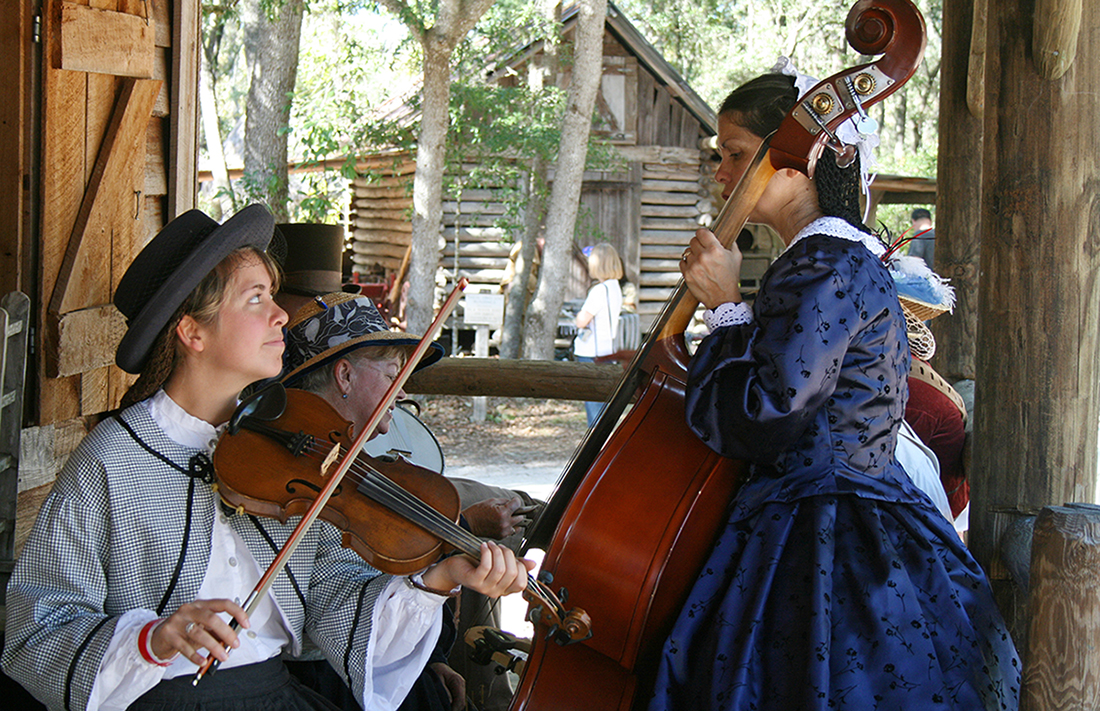Entertaining on the Florida frontier varied based on the cultures of residents and historical periods of time.

History is often complex, nuanced and fluid. It is in our nature to remember things in ways that fit our idea of how the world should have looked. Entertaining on the southernmost frontier is no exception, but the reality is that Florida has always been diverse. In short, there has always been more than one way to throw a party.
Our ancestral Floridians entertained guests in ways that are still popular today and in ways that are no longer in fashion. It is important to note that the settlers in the Deep South came from many cultures and varied widely depending on the time period. Feasts around a campfire, formal parties reminiscent of the finest courts in Europe and simple community dances are but a few examples of how our forebearers entertained.
During the first Spanish Colonial Period (1513 to 1763), North Florida was home to mostly Native Americans, Spanish citizens, free African Americans and people with mixed heritage. How people entertained depended on their social status and where they lived. Officers at the Castillo de San Marcos in St. Augustine attended formal gatherings in town while free Black residents living at the garrison of Fort Mose would have feasted with local Guale and Timucuan people on wild game and shellfish in the salt marsh north of the old city. These were simple gatherings by our standards and would have surely involved food, drink, music and, most likely, dancing.
By the time of the British Period (1763-1783), which also roughly coincides with the American Revolution, the state was divided into two regions—East Florida and West Florida. British subjects and the few Spanish people who remained lived in coastal towns while Seminole and Creek Indian communities flourished inland. Social gatherings were much the same as before and remained simple affairs.
 Once the American colonists won their independence, Florida was transferred back to Spain for the Second Spanish Period (1783-1821). Life was hard and hosting family and friends would have offered a welcome reprieve from daily struggles. Music and food would have been heavily influenced by Spanish and perhaps even Moorish cultures, with a hint of influences from the people of the British Isles, Native Americans, Minorcans and Africans, depending on your location and crowd. In the absence of modern media, storytelling would have been a cherished entertaining skill.
Once the American colonists won their independence, Florida was transferred back to Spain for the Second Spanish Period (1783-1821). Life was hard and hosting family and friends would have offered a welcome reprieve from daily struggles. Music and food would have been heavily influenced by Spanish and perhaps even Moorish cultures, with a hint of influences from the people of the British Isles, Native Americans, Minorcans and Africans, depending on your location and crowd. In the absence of modern media, storytelling would have been a cherished entertaining skill.
The Territorial Period (1821-1845) lasted up until statehood, when Florida was admitted to the United States. The Armed Occupation Act of 1842 encouraged people to settle in Florida with the offer of free land. Many with English, Scottish and Irish heritage moved south to carve out homesteads. By this time, many of the Spanish inhabitants had left and Seminole culture was under attack from the U.S. government. The citizenry of the peninsula changed dramatically and the pioneers we are familiar with today emerged and persisted well into the early to mid-1900s. Many of our earliest local families moved to Marion County during this time.
Entertaining during this period would have included both family and community gatherings for religious holidays, weddings, harvests, cane boils and special occasions such as birthdays. Offering large meals, playing music, recounting stories, reciting poetry and playing games were popular. Horse races, gambling and traveling fairs may have also been available but were not common. Communal square dances and contra dances would have allowed for communities to come together and, aside from family connections and church, afforded young couples an opportunity to meet and court.
As we enter this holiday season and begin to plan our family parties, remember our diverse heritage and consider adopting a custom from the past for your own gathering. Tell an entertaining tale, plan a game or organize a family dance. You may be surprised by the fun you have as you party like a pioneer! OS
Scott Mitchell is a field archaeologist, scientific illustrator and director of the Silver River Museum & Environmental Education Center, located at 1445 NE 58th Ave., Ocala, inside Silver River State Park. To get a glimpse of pioneer life in Marion County, visit the annual Ocali Country Days festival at the museum on November 11th and 12th. To learn more, go to silverrivermuseum.com






